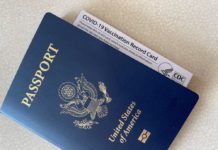Perhaps no industry is as closely watched when it comes to the pandemic as cruising. Even after their return to sailing following a lengthy pause, the CDC issued the Conditional Sailing Order (CSO) that laid out the rules and protocols needed for ships to sail again.

After an extension of the CSO, the health agency moved the rules to voluntary status starting January 15, 2022. Foreign-flagged cruise ships (of which most are) could now decide whether they wanted to keep up the protocols or not.
Since then, little has changed as cruise lines have continued to follow the protocols put in place before the change to voluntary status. Rules around masking, testing, and vaccines have been kept in place.
And while the Omicron variant saw cases spike on ships just as on land (including a reported 5,000 cases in two weeks in December), cases seem to now also be falling sharply. Royal Caribbean Group CEO Jason Liberty even commented that his company has seen cases fall back to “pre-Omicron levels.”
Now the CDC is rolling out updated “technical instructions” for cruise lines should they choose to opt-in to its now voluntary program. Instead of easing restrictions as we’re seeing in many places, the tough cruise rules stay in place. And beyond that, some bigger changes have been made.
Multiple Tiers for Vaccination Levels
Cruise ships currently sailing in U.S. waters have until February 18, 2022 to let the CDC know if they plan to adhere to the new voluntary rules. Should they choose to do so, then one of the biggest changes will come in the form of new categories based on the vaccination status on those on the ship.
The CDC now plans three different classifications of cruises:
Not Highly Vaccinated: These are ships sailing with less than 95% of passengers and crew sailing fully vaccinated.
Highly Vaccinated: Ships with at least 95% of passengers and crew fully vaccinated, but less than 95% considered “up to date” with their vaccines. “Up to date” means having a booster dose of Pfizer or Moderna at least five months after their second dose. If vaccinated with Johnson & Johnson, it means having a booster at least two months after the initial shot.
Vaccination Standard of Excellence: This new category encompasses ships that have at least 95% of passengers and crew “up to date” with their COVID vaccines, meaning eligible passengers have a booster shot.
Quarantine Rules for Positive Tests & Close Contacts
If positive cases are found, then they are to be isolated from other passengers and crew. As well, close contacts must quarantine to help further prevent spread.
In this case, the CDC is putting in protocols requiring the length of that quarantine. For ships that are considered “highly vaccinated” or “not highly vaccinated” the quarantine for close contacts is set to last for 10 days or until disembarkation.
For ships with the “Vaccination Standard of Excellence” status, that quarantine time is five days or until disembarkation.

These rules are even for those that are vaccinated (or even boosted), have no symptoms, and test negative on the ship. The one exception is if a person has a documented recovery from COVID in the past 90 days. In that case, no testing or quarantine is required.
Color Status Changes
For months the CDC has reported daily color status of every foreign-flagged cruise ship sailing U.S. waters. We’ve provided historic tracking of these reports on Cruzely.
When first introduced, those colors were assigned as green, orange, yellow, and red. This led to considerable confusion as orange is logically closer to red, yet was considered a better status than yellow.
As well, the color status was also cumbersome due to the rules surrounding assigning a status based on who was ill on the ship. For instance, if one passenger was sick, then an orange status was earned. But if one crew member was sick, then that status was instead yellow.
Now the agency has made changes to the color system. First, the status order reversed orange and yellow, which the CDC says is “to go in a more logical color order.”
As well, there are simpler guidelines for assigning the color status based on the total number of people sick versus the number of people on the ship:

If a ship is sailing with passengers, it will now earn yellow status when there are cases in less than 0.3% of total passengers and crew. Orange status is given for ships with 0.3% or more of passengers and crew having cases.
And while there have yet to be any red-status ships, there were more concrete rules laid out as to when this color would be given.
Will Cruise Lines Opt-In to the Voluntary Program?
To be sure, many of the protocols laid out in the voluntary program are similar to what was seen when the Conditional Sailing Order was still a requirement. Even so, there are signs the industry feels it is still being singled out.
In a statement from Cruise Lines International Association (CLIA), an industry trade group, the tone was clearly unhappy.
First, CLIA pointed out that unlike other areas of travel and tourism, cruise ships “test all persons boarding, have medical, isolation and quarantine facilities on site, implement extensive response plans using only private shoreside resources, and have created an environment where almost every single person is fully vaccinated.”
“We are confounded by the CDC’s imposition of even more complex and unwarranted measures which ignore empirical evidence that the industry’s protocols have provided a greater level of COVID mitigation than most any other setting,” the statement continued.
“The CDC’s guidance for multi-tiered cruises is counterproductive to consumers, creating market confusion between the various tiers, and potentially unworkable in practice”
At least one company — Norwegian Cruise Line Holdings Ltd. — has said it will opt into the CDC’s voluntary plan. However, that was before these guidelines were released. If the instructions will have any impact on Norwegian’s decision has yet to be seen.
Given the strong statement from CLIA, it seems possible some cruise lines will not be happy with the new guidelines.













how is a “close contact” defined. My spouse? my waiter? someone i passed in the hallway??
The general consensus is someone you spent 15 minutes within six feet. So someone you passed by would not be considered a close contact. Your spouse? Yes.